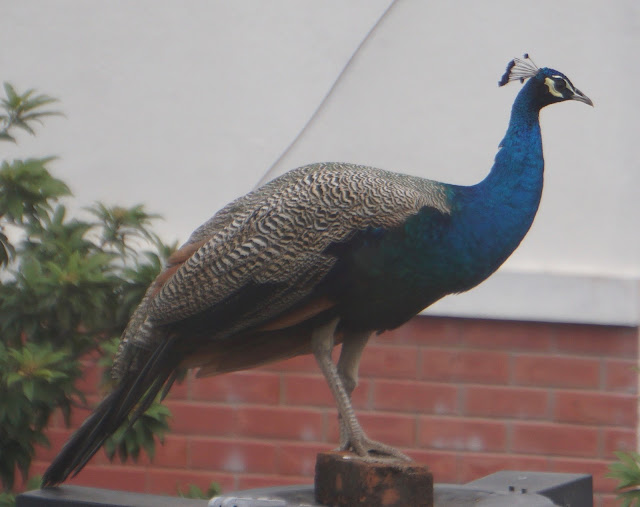Chennai resident crosses birding milestone, documents 100 species from hearthstone
Sundaravel Palanivel recently reached the three-figure mark, remarkably through patch birding from his home in Pallikaranai. His observations and photographic records include around 10 rarities and many insightful avian patterns
Any successful flourish of the bat or a breakthrough with the ball or any defining moment in a match would instantaneously whip up a frenzy in the stands. It would combine the spontaneity that goes with deliriously delighted fans and the craft associated with professionally trained cheerleaders.
When Sundaravel Palanivel ran up a workmanlike hundred recently, there was a rare form of cheering with spontaneity and aesthetics seamlessly woven into it. In that moment when he looked through the viewfinder at a dancing forest wagtail and pressed down the shutter-release button, and reached that magical three-figure mark, the sense of achievement was inescapable. That untrained but delectable cheerleader perfected that moment of glory. For the uninitiated, the forest wagtail does a sideways sway in elegant contrast to the almost frenzied up-and-down tail-bobbing of other wagtails.
It was a hundred counted not by runs, but feathers; and the duration in which it was achieved measured not by balls, but 24-hour days. With the sighting and recording of the forest wagtail, Sundaravel was documenting the hundredth bird species from his hearthstone. He had amassed that score in a two-to-three-year time frame, sedulously applying himself to confiding the sightings to an excel sheet.
Sundaravel travels long and often in the hope of clapping eyes on rarities, but has also stayed faithful to his patch which he watches with eyes peeled back.
The fact that he is domiciled at Kamakotti Nagar in Pallikaranai, and the view outside includes spits of land and water that borrow their character from the Pallikaranai Marsh was surely an incentive.
His apartment is located on Third Main Road Kamakotti Nagar, which is overlooked by the tall NIOT campus ringed by trees that are taller still. While many of the bird sightings happened on this road and the terrace of his four-floor apartment complex, he also ranges around the neighbourhood, heading into streets nearby where nature plays peekaboo with civilisation, giving a fleeting glimpse of its largesse. The entries in the sheet locate each of the streets around his hearth where sightings happened.
The trees that rear up majestically on the NIOT campus serve as cradle for newborns of big waterbirds, which include the black-headed ibis, spot-billed pelican, Eurasian spoonbill and members of the heron and egret families. Though the nest-laden trees — in the breeding season — are out of range for his telephoto lens, Sundaravel has managed to freeze frames touched on the edges with heart-warming domestic scenes of parent-birds leading their young out on trial flights.
An almost permanent collection of water adjacent to the campus functions as a play school for fledglings. These are only the predictable factors his viewfinder is accustomed to. Unexpected feathers are often known to flit across that lucky eyepiece.
Out of the hundred, around 10 would be rarities. The others are regular residents, migrants and local-migrants, notes Sundaravel. No sighting can compete with any other, as each brings with it its own unique insight, with some even completing patterns.
Over the last two years, he has seen the Asian pied starling take ownership of the space, from just one breeding pair to at least four pairs now. The sighting and documentation of these breeding pairs etch a curious picture of the species' range expansion into Chennai, a recent phenomenon attested by other sightings from birders from other parts of the metro. Not long ago, northern Andhra Peradesh was believed to bring up the southern bounds of this species' distribution range in India.
There have also been sightings from home that are not exactly grounded. In the hours after cyclone Nivar (November 23-27, 2020) had crossed the coast, an Amur falcon crossed his path, its journey to its faraway wintering grounds in southern and east Africa evidently rescheduled and rerouted through Sundaravel's "airway", by the weather system. Interestingly enough, Sundaravel saw the obviously-windblown Amur falcon, winging far above his apartment complex, at the exact moment that he was discussing sightings of storm-tossed and windblown pelagic birds with this writer. Excusing himself, the birder dropped out of the call, and returned to announce his "windfall".
The best patch-birding day for him arrived this year on April 3, when he watched two rare warblers that are passage migrants in these parts — the large-billed leaf warbler and western crowned warbler. These birds had invited themselves to his apartment, and the unlikelihood of those visits makes one wonder if birds do wise up to human ways: And that these two were probably aware of the excel sheet in Sundaravel's laptop.
Another passage migrant, one that is discovering new pitstops in Chennai, the chestnut-winged cuckoo features in Sundaravel's coveted list.
Other notables on the patch-birding list include the gray-bellied cuckoo, red-necked falcon, sooty tern, cinnamon bittern, black bittern, yellow bittern, Caspian tern, lesser cuckoo, Asian brown flycatcher, garganey, long-tailed shrike, brown shrike, wood sandpiper, marsh sandpiper, western yellow wagtail, Blyth's reed warbler, citrine wagtail, rosy starling, fulvous whistling-duck, striated heron, pheasant-tailed jacana, Indian paradise-flycatcher, white-browed bulbul and an elusive and awkward skulker, the blue-faced malkoha.

























